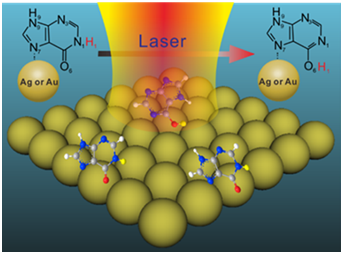In general, a vast amount of specific information is present in serum, and the information can be utilized for therapeutic ordiagnostic purposes. However, many reports have indicated that changes in the critical experimental parameters of laser power and substrate identity may lead to significant changes in serum spectral bands during surface-enhanced Raman scattering (SERS) measurements.
The paper published in the journal of Nanoscale(Nanoscale, 2017, 9, 12307–12310 ) (http://pubs.rsc.org/en/content/articlepdf/2017/nr/c7nr04050d) by Prof. YANG Liangbao’s team of Institute of Intelligent Machines (IIM), Hefei Institutes of Physical Science, Chinese Academy of Sciences found that the intramolecular proton transfer of hypoxanthine is induced by application of a laser on the surface of a bare noble nanomaterial.
As an intermediate of the metabolism of nucleic acids in living systems, hypoxanthine is the primary contributor to the SERS signal of serum, and it can participate in proton transfer because of its intrinsic features in different environments.
Moreover, the concentration of hypoxanthine in the serum is in the range of 0.9 to12.0 μM. The concentration of hypoxanthine in the serum is under control in the study.
The serum from the CAS Hefei Cancer Hospital was added to a concentrated metal colloid in a 1 : 1 volume ratio and the resulting solution was dried on a Si wafer. SERS was obtained from the dried solution.
The successful detection of proton transfer phenomenon of hypoxanthine in serum offers a new explanation for the differences of the SERS of serum under different experimental conditions.
Moreover, the research paves the way for real-time monitoring of the proton transfer reaction in biochemistry studies which are related to physiological andpathological events
This work was supported by the National Science Foundation of China (21571180 and 21505138), Special Financial Grant from the China Postdoctoral Science Foundation (2016T90590) and the China Postdoctoral Science Foundation (2015M571950).

Schematic illustration of the proton transfer of hypoxanthine in the presence of noble metal nanoparticles under a 633 nm-wavelength laser with a power density of 11.2 mW μm−2(Image provided by ZHOU Binbin)
Article link: http://pubs.rsc.org/en/content/articlepdf/2017/nr/c7nr04050d
Title: Real-time monitoring of plasmon-induced proton
transfer of hypoxanthine in serum
Key words: proton transfer;hypoxanthine; SERS; serum; monitoring
Prof.YANG Liangbao, Ph. D Principal Investigator
Institute of Intelligent Machines, Chinese Academy of Sciences (http://www.iim.cas.cn/) Hefei, Anhui 230000, China
Tel:86-551-6559-2385
Email:lbyang@iim.ac.cn.
